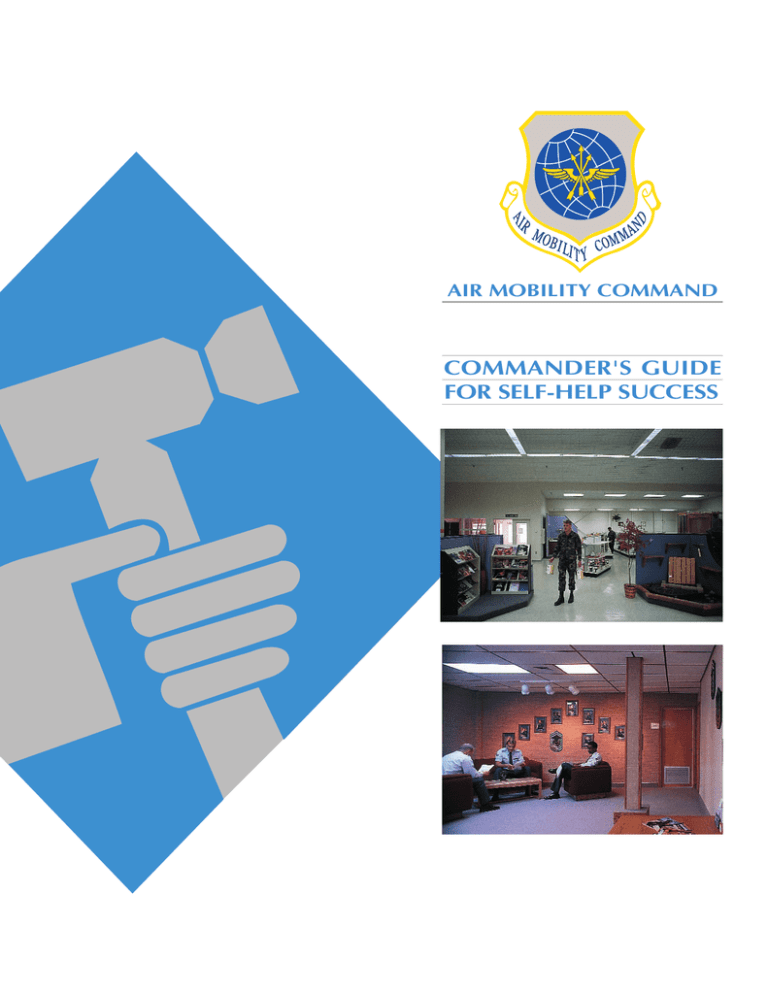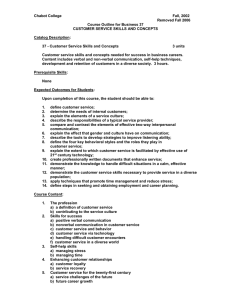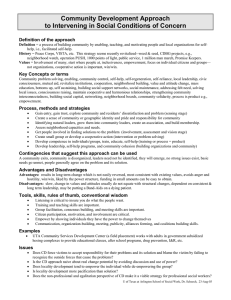COMMANDER'S GUIDE FOR SELF-HELP SUCCESS AIR MOBILITY COMMAND
advertisement

AIR MOBILITY COMMAND COMMANDER'S GUIDE FOR SELF-HELP SUCCESS The Air Mobility Command strongly promotes upgrading its facilities through the use of self-help. Self-help offers all organizations an opportunity to improve their facilities immediately and with significant savings over contract costs. These improvements build unit morale, individual pride, and serve to project the professional attitude of AMC personnel. The quality and workmanship found in Self Help projects are a testament to the skill of our people and the standards set in our previous self-help guide. This revision will provide you with the inspiration and ideas for transforming dated facilities or work centers into model projects using self-help. Table of Contents Introduction 3 Self-Help Concept Self-Help Store Self-Help Staff Store Layout Self-Help Success Organizing For Success 8 Small Projects Large Projects Standards 11 Color Schemes Finishes Lessons Learned 14 Project Management Real Property Records and Facility Drawings Material Management and Tool Control Conclusion Appendix Interior Finish Specifications 2 16 A-1 Introduction Self-Help Concept With manpower and funding in short supply, self-help offers wing commanders a way to leverage limited facility improvement resources. Self-help encourages facility users to “take charge” of their offices, living spaces, and recreational areas. The program provides an excellent method to achieve facility improvement and foster a sense of “ownership” and unit pride. By fostering this sense of pride, self-help projects contribute to successful mission completion and improved user care of facilities. To capitalize on this opportunity, the self-help program should: Self-help workers produce projects with the quality of civil engineering in-house or contract efforts. ♦ Establish a “team approach” that actively involves unit commanders and senior NCOs. ♦ Set goals, identify requirements, establish priorities, and designate roles and responsibilities for execution. ♦ Be responsive and customer oriented. ♦ Encourage projects for the “community” like playgrounds, pavilions, and bus shelters. Community projects develop base pride. ...Self-help projects contribute to successful mission completion and improved user care of facilities. Stock store with materials frequently needed for facility maintenance, repair, and upgrades. 3 Self-Help Store The heart of the self-help program is the wing selfhelp store. The self-help store provides materials, equipment, and technical support, including training and assistance, to customers who want to help themselves. Allow customers convenient access to materials. ♦ The store should resemble similar commercial facilities that support “do-it-yourself” work in the civilian community. It should be stocked with materials commonly used in facility maintenance, repair, and upgrade. ♦ The store’s physical layout should allow customers to conveniently shop for materials. Figure 1, page 5, represents typical operations and space relationships for a self-help store. This layout will assist you with visualizing the required store functions. Each base should develop its own store requirements appropriate to local functions, size requirements, and facility constraints. ♦ Support all base customers, including military family housing (MFH) occupants, from the same store. Self-help store exterior sets the standard for self-help attitudes. Self-Help Staff Staff members of the self-help store are very important to the success of the program. They provide the service, skills, and continuity required for every project from beginning to end. ♦ Self-help store workers should limit delays, provide training when necessary, and work closely with customers to streamline the approval and execution of projects, regardless of project size. Let customer have access to what the store offers. 4 ♦ Personnel of various skills should be assigned to the store. The wider the range of skills store personnel possess, the more responsive the store can be to its customers. Store Layout Tool Room WAREHOUSE B u l k Catalog L u m b e r How-To Video Mock-Up Display Hardware Hardware Carpentry Carpentry Hardware Plumbing Carpentry Carpentry Plumbing Carpentry Carpentry Electrical Rest Room Planners' Desks Supervisor STORE Seasonal Issue Items Delivery Door OFFICE Display Ser vice Entry/Exit Figure 1 5 ♦ In addition to job knowledge, the staff’s attitude plays a major role in program success. These people should be self-starters who combine enthusiasm with hard work to help customers complete quality projects. Self-Help Success Store layout should mirror commercial outlets. To maximize base participation, you should publicize the program, speed customer requests, eliminate unnecessary paperwork, provide “one-stop service,” and encourage customer participation. You should stress the following areas: ♦ Convenient Operating Hours - Establish hours to match your mission and potential work force schedule. ♦ Self-Help Store Exterior Appearance - Strive to establish and maintain a high-quality exterior appearance. This sets the standard for self-help attitudes. Ensure sufficient parking is available. A landscaping display enhances the store’s appearance and generates customer ideas for self-help landscaping work. A high-quality paint job, in compliance with the base exterior paint scheme, sets the baseline for the entire base’s appearance. ♦ Store Displays - Arrange store shelves to resemble those at commercial outlets. Allow customers to touch and feel what you have to offer. Display finished quality walls, ceilings, floors, and other features. Build store offices/display rooms to reflect the combinations of approved wall/carpet colors, trim choices, chair rails, lighting, etc. Show the variety of approved materials, color schemes, and building techniques customers are to use in their projects. Mock-ups show typical installation of materials stocked in store. 6 ♦ How-To Pamphlets - Have available step-by-step instructions for common work tasks like: laying floor tile, installing drywall, drop ceilings, etc. Creative Homeowner Press, (800) 631-7795, distributes a wide selection of reasonably priced pamphlets. ♦ How-To Books - Keep these reference books on hand for customer use. Many commercial publishers, such as Time-Life, distribute excellent home repair and construction manuals. Put these books in your base library, too. ♦ Video Instruction - Providing instruction by video is an excellent way to teach. A wide range of “howto” videos are commercially available. You may also want to use your local audiovisual organization to make your own instructional tapes. Videos are especially helpful when store space for hands-on training mock-ups is not available. Video instruction is an excellent teaching method. ♦ Training Seminars - Help customers produce higher quality work by offering training seminars in basic skills such as wall framing, wallboard work, plumbing, and electrical work. Hold these seminars during lunch, in the evenings, or at other times to meet specific customer needs. ♦ Training Aids - Display typical installation mockups showing materials stocked in the store. Common mock-ups show wall framing, drop ceiling installation, plumbing, and electrical schemes. ♦ Tools/Equipment - Maintain an assorted supply of tools and/or tool boxes to loan out for self-help work. Train individuals regarding proper use and safety precautions prior to issuing power tools. Ensure accountability of tools/equipment with a proper inventory system. ■ Use landscaping to enhance the facility’s appearance. Offer customers information and training in basic skills to accomplish their projects. 7 Organizing for Success Small Projects Small projects normally can be completed by an organization or family housing occupant without outside assistance. Examples include installing of wall paneling or drywall, suspended ceilings, laying floor or carpet tiles, and landscaping. The following procedures work well for small projects: ♦ The organization/MFH occupant submits a work request to the self-help store. Self-help project concepts are limited only by customer imagination. ♦ All required planning is done by store staff on the spot. ♦ Issuing materials on the spot is the best way to maintain the momentum of the self-help program. ♦ Training, assistance, and coordination of any Civil Engineering (CE) shop support should be provided by the self-help store. ♦ A final inspection should be conducted by store personnel to ensure work is accomplished to AMC standards. Durable, easy-to-maintain finishes are essential to user satisfaction and appearance. Using bright colors in offices encourages improved job performance. 8 Successful self-help programs encourage customer participation. The self-help store should stock minor maintenance and repair items that first sergeants, dorm and facility managers, and family housing occupants can draw without submitting a detailed written work request. Standard items that should be kept in stock include electrical receptacle covers, faucet repair kits, caulking, and air conditioning filters. The self-help store should coordinate the storage and issue of paint, adhesives, and other hazardous construction materials through the base Hazardous Material (HAZMAT) Pharmacy. ■ Large Projects Many large projects are efforts that cannot be handled by individual organizations due to project scope or technical requirements. Dormitory renovations, total facility upgrades, and pavilion construction are examples. While technically not self-help, you may elect to use a quality-work-in-construction (QWIK) work force to accomplish large projects. These workers should be loaned to the CE organization and, for labor accounting purposes, be treated as regularly assigned CE personnel. Use a separate shop rate category and cost center for temporary assignment of the QWIK team members to minimize the impact on CE shop rates. Community projects benefit the entire base. A senior NCO with strong managerial experience should lead the QWIK work force. CE provides planning, material acquisition, and technical support for the team. Personnel should be loaned to civil engineering for a locally determined period of time. Procedures for accomplishing a large project follow: ♦ Unit commanders should request QWIK team sup- port when their project is too large or otherwise beyond the unit’s capability. ♦ Self-help manager decides if this is a valid self-help project, provides an initial cost estimate, and forwards it, through the base civil engineer and support group commander, to the wing commander’s office. Complex projects lend themselves to accomplishment by an experienced self-help team. ♦ The wing commander should make the final decision on project approval and establish project priority. ♦ QWIK team manager works with user and self-help planners to finalize project design. ♦ Self-help store staff determines material availability and orders material if necessary. Some projects, such as constructing this control center, require substantial technical support from CE. 9 ♦ QWIK team manager schedules work based on established priorities. ♦ Self-help store coordinates civil engineering shop support. ♦ Work should be completed as quickly as possible with emphasis on early execution by QWIK and CE as a team. ♦ In-progress and final inspections should be con- ducted by appropriate CE supervisors to ensure finished work meets AMC standards. Use the QWIK team for projects beyond a unit’s capability. Allow self-help team members to train using in-store mock-ups before tackling large projects. 10 ■ Standards The standardization of interior finishes assures the interior decor retains continuity throughout each facility. AMC has adopted interior finishes as the command standards for self-help work. They reflect the Air Force standard of understated excellence and are functional, durable, and easy to maintain. Family housing standards are outlined in the AMC Commander’s Guide to Family Housing Excellence and the AMC Housing Guide. The command standard consists of three complete interior design schemes (see interior finish specification in appendix) with combinations of appropriately selected colors and materials. Mock-ups of all three schemes have been provided to each self-help store to help customers select a scheme and visualize their finished products. Individual user requirements, such as those of office areas, areas with special maintenance requirements, and areas where a more distinguished appearance is required, will determine the specific finish needs for each project. Standards ensure continuity and user satisfaction. A superior self-help project also requires quality furnishings. Furniture, artwork, wall decor, and plants should be selected to complement and reinforce the interior design scheme. Customers should get professional design advice as they put the furnishings in each project. Improved interiors promote workplace accomplishments. Standardization creates facilities that reflect the AMC tradition of excellence. 11 Color Schemes The AMC self-help program has three approved interior color schemes. (These schemes do not apply to family housing units.) Each scheme consists of a variety of finishes appropriate for various applications. All finishes for each project must come from the same scheme. Specifications for each scheme are listed in the Appendix. The three schemes were chosen to ensure the quality and longevity of the materials, while maintaining AMC standards. Substitutions will be considered if the product meets the specifications of the original and is compatible with the rest of the color scheme. All changes/substitutions must be approved prior to procurement. Please contact the AMC Design Center for approval of substitutions and reselection of discontinued items. AMC Design Center (618) 256-5107 DSN 576-5107. Finishes Floor Covering - Six flooring choices are available, depending on the finish required. Base - Standard vinyl base will be used throughout most projects. It provides ease of maintenance and durability. Wood base can be used in offices of senior officers and civilian equivalents. Wood base should match wood trim used on doors, door frames, and chair rails. Vinyl Wall Covering - Two choices of covering for smooth/drywall surfaces can upgrade the finish. Choice One - Use above a chair rail or as an overall wall covering; e.g., in hallways, offices, and conference rooms where an upgraded finish is desired. Choice Two - Use below the chair rail as an accent; e.g., in offices of senior officers and civilian equivalents, conference rooms, and areas where a more prestigious appearance is desired. Not recommended as an overall wall treatment. Textured Plaster - Use over drywall or concrete block walls for a cost-effective finish upgrade in limited use areas. Not for use on paneled, papered, durasan, or other similar wall finishes. Vinyl Composition Tile - Use in service, janitorial and maintenance areas, latrines, and other high-soil areas. Benefits are ease of maintenance and durability. Laminate - Use on cabinet tops and horizontal surfaces. Quarry Tile - Use in high-maintenance areas where extreme durability is required. Can be used for both indoor and outdoor projects. Mini Blinds - Can be used in all projects where window treatment is required. Use one color to provide an overall uniform appearance. Ceramic Tile - Use in areas where water and moisture are present, such as lobbies, rest rooms, and break rooms. Provides ease of maintenance and durability. Drapes - For offices and conference rooms of senior officers and civilian equivalents and other highprofile areas. Carpet Tile (Main) - For general use wherever carpet is required. It is very easy to install, and the overall pattern conceals stains and traffic wear. Provides easy replacement, storage, and flexibility. Most self-help carpeting will use carpet tile. Paint - Where ease of maintenance is necessary, and drywall/vinyl covering are not options, paint is recommended. Each scheme has two color choices. Carpet Tile (Border) - Use as an accent in public areas, such as hallways and reception rooms, or wherever a definition of space is required. 12 Broadloom Carpet - Use in offices of senior officers or civilian equivalents, conference rooms, and other high-profile areas. Overall Paint Color (A & B) - Select one color to use on walls, columns, and doors. Accent Paint Color - Use on doors, window frames, and trim. Ceiling Tile - Use a 2’ by 2’ standard system. Two variations are authorized, depending on the level of finish required. Pattern Ceiling Tile - Use in offices of senior officers and civilian equivalents, conference rooms, and other areas where a more prominent look is desired. Base standards should be established for plumbing, electrical, and mechanical fixture selections. Understated excellence is the standard. Extravagant accessories must be avoided. Keep selections simple to maintain continuity. Pick a standard and stick with it. ■ Standard Ceiling Tile - Applicable in all other projects. Coordinate new construction finishes and appropriate furniture with user requirements. 13 Lessons Learned Self-help is a valuable tool for organizations to accomplish projects within their capabilities. In certain instances, Air Force auditors have found some self-help efforts to reflect fraud, waste, and abuse. Areas identified by auditors that require control procedures include: Project Management ♦ Establish controls to ensure work requests are approved by unit commanders and no fire or safety hazards are built. Each element and detail of a project must reflect a sense of unity. ♦ Ensure projects follow established Air Force funding procedures. ♦ Ensure the project is feasible and within the customer’s ability to complete. ♦ Verify work is progressing as planned with in-progress inspections conducted by store personnel. A final inspection should conclude that the work was completed in a professional manner and within AMC standards. ♦ Document final inspection results. The Civil Engineering Work Information Management System (WIMS) is designed to keep these records. Recreational areas provide space for relaxation. Real Property Records and Facility Drawings The Base Civil Engineer’s staff must: ♦ Update real property records to show the results of self- help projects. ♦ Establish and follow procedures to update drawings and floor plans to accurately show facility interiors. Material support areas should be safe and provide ample space to do the job. 14 Material Management and Tool Control ♦ Issue and receive materials according to established regula- tions for credible audit trails. ♦ Issue materials only to authorized self-help customers. ♦ Ensure excess project materials are returned to the self-help store. Keep accurate residual material records. ♦ Complete temporary issue receipts and take action to ensure tools and equipment are returned. Select durable finishes for high-use areas. ♦ Establish accountability for tools. Perform regular inven- tories. Maintain a wide selection of power and hand tools. The following is a summarized list of essential tools and equipment that are required to operate a successful selfhelp store. Hand Tools Powered Equipment Multiple screwdriver sets Various chisel sizes Saws (hand, hacksaw, coping) Nail sets Landscaping hand tools Utility knives with multiple blades Wrenches (various sizes) Levels Files (various textures) Tape rules Tile cutters Paint brushes and rollers Hammers (16oz and 20oz) Block and Jack planes Masonry tools Ladder (step and extension) Drill bit sets Miter box Caulking guns Socket set (universal and metric) Router Saws Circular Table Miter Saber Landscaping items Tiller Hedge trimmer Chain saw Electric sanders (belt and rotary) Drills Power Cordless Paint sprayer Paint agitator Brazing and soldering set Hilti hammer drill Mortar/cement mixer Air compressor ■ 15 Conclusion Self-help promotes pride, ownership, and is instrumental in providing quality facilities for the Air Mobility Team. To assist self-helpers, each base must have a self-help store that is convenient, well-stocked, and responsive to individuals performing approved self-help projects. The program must be managed to avoid wasted efforts and resources. Completed personal, organizational, and base team projects must be consistent with the project approved and AMC standards, while fostering teamwork and improving quality of life. ■ Self-Help…A Partnership of Professionals…Building Greater Facility and Environmental Excellence. 16 Appendix Interior Finish Specifications Item Description Scheme 1 101 Carpet Tile (Border) Brand: Lee’s Commercial Carpets Pattern: Wayfinder (LS342) Color: #515 Mulberry Source: Same As Item #101 103 Carpet (Broadloom) Brand: Bigelow Pattern: Newport News (NWPN) Color: 39389 Corundum Source: Bigelow Three Westbrook Corporate Center Suite 550 Westchester, IL 60154 ATTN: Susan Phillips (314) 821-2111/(314) 821-2212 FAX 105 Description 106 Vinyl Wall Covering (Above Chair Rail/Floor to Ceiling) Brand: Essex Pattern: Stoneart #SP-57-01 Color: Dry Sage Width: 54” Source: MDC 1200 Arthur Avenue Elk Grove Village, IL 60007 ATTN: Michelle McCartney (314) 861-3744/(314) 861-3815 FAX 107 Vinyl Base Brand: Armstrong Color: #72 Mouse Gray Source: WC Tingle Co. 5 American Eagle Plaza Earth City, MO 63045 ATTN: Michelle Colbert (888) 846-4535/(314) 209-0484 FAX 108 Vinyl Composition Tile Brand: Armstrong Color: #51901 Taupe Texture: Imperial Texture Source: Same As Item #107 109 Paint (Accent Color) Brand: Sherwin Williams Classic 99 (Semi-Gloss) Color: SW 1033 Slippery Rock Carpet Tile (Main) Brand: Lee’s Commercial Carpets Pattern: Attribute Color: #307 Marcipan Source: Lee’s Commercial Carpets 3330 West Friendly Avenue PO Box 26027 Greensboro, NC 27420-6027 ATTN: Kevin O’Brien (314) 863-8735/(314) 863-2187 FAX 102 104 Item Laminate Brand: Wilsonart Color: Mahogany #D384-6 Source: Ralph Wilson Plastics, Co. 1100 Chase Avenue Elk Grove Village, IL 60007 ATTN: Debbie Opfer (708) 742-8181 Vinyl Wall Covering (Below Chair Rail) Brand: Vicrtex-Colorlights Pattern: Willow-I Color: Ecole Grey Source: Chrismar Inc. 1771 Larkin Williams Road Fenton, MO 63026-2032 ATTN: Michael A. La Plante (314) 343-1255/(314) 343-0640 FAX Paint (Overall Color) Brand: Sherwin Williams Classic 99 (Flat) Color A: SW 1018 Sleek White Color B: SW 1031 Modern Grey Source: Sherwin Williams 700 Carlyle Avenue Belleville, IL 62221 (618) 233-0191 110 Chair Rail Brand: Standard Stock A-1 Item Description Scheme 2 201 Carpet Tile (Main) Brand: Lee’s Commercial Carpets Pattern: Attribute Color: #135 Flowering Plum Source: Lee’s Commercial Carpets 3330 West Friendly Avenue PO Box 26027 Greensboro, NC 27420-6027 ATTN: Kevin L. O’Brien (314) 863-8735/(314) 863-2187 FAX 202 Carpet Tile (Border) Brand: Lee’s Commercial Carpets Pattern: Wayfinder (LS342) Color: #307 Maritime Blue Source: Same As Item #201 203 Carpet (Broadloom) Brand: Bigelow Pattern: Newport News (NWPN) Color: 21596 Indigo Source: Bigelow Three Westbrook Corporate Center Suite 550 Westchester, IL 60154 ATTN: Susan Phillips (314) 821-2111/(314) 821-2212 FAX 204 205 Item Description 206 Vinyl Wall Covering (Above Chair Rail/ Floor to Ceiling) Brand: Bolta Pattern: Hardrock II #BB-HC-35 Color: Ashen Source: Thybony 3720 North Kedzie Avenue Chicago, IL 60618 ATTN: Steven Niebruegge (314) 994-0053/(773)463-8988 FAX 207 Vinyl Base Brand: Armstrong Color: #59 Charcoal Gray Source: WC Tingle Co. 5 American Eagle Plaza Earth City, MO 63045 ATTN: Michelle Colbert (888) 846-4535/(314) 209-0484 FAX 208 Vinyl Composition Tile Brand: Armstrong Color: #51904 Sterling Texture: Imperial Texture Source: Same As Item #207 209 Paint (Accent Color) Brand: Sherwin Williams Classic 99 (Semi-Gloss) Color: SW 1226 Winter Cloud Laminate Brand: Wilsonart Color: #D379-6 Indigo Source: Ralph Wilson Plastics, Co. 1100 Chase Avenue Elk Grove Village, IL 60007 ATTN: Debbie Opfer (708) 742-8181 Vinyl Wall Covering (Below Chair Rail) Brand: Plexus-Designers Portfolio Pattern: Milano - 2158071 Color: Slate Blue Source: C & A Wallcoverings, Inc. 2 Bliss Terrace Collinsville, IL 62234 ATTN: Mary Belle McMackin (800) 356-6671 Paint (Overall Color) Brand: Sherwin Williams Classic 99 (Flat) Color A: SW 1018 Sleek White Color B: SW 1522 Starlight Source: Sherwin Williams 700 Carlyle Avenue Belleville, IL 62221 (618) 233-0191 210 Chair Rail Brand: Standard Stock A-2 Item Description Scheme 3 301 Carpet Tile (Main) Brand: Lee’s Commercial Carpets Pattern: Attribute Color: #328 Grey Flannel Source: Lee’s Commercial Carpets 3330 West Friendly Avenue PO Box 26027 Greensboro, NC 27420-6027 ATTN: Kevin L. O’Brien (314) 863-8735/(314) 863-2187 FAX 302 Carpet Tile (Border) Brand: Lee’s Commercial Carpets Pattern: Wayfinder (LS342) Color: #328 City Grey Source: Same As Item #301 303 Carpet (Broadloom) Brand: Bigelow Pattern: Newport News (NWPN) Color: 41225 Steel Source: Bigelow Three Westbrook Corporate Center Suite 550 Westchester, IL 60154 ATTN: Susan Phillips (314) 821-2111/(314) 821-2212 FAX 304 305 Laminate Brand: Wilsonart Color: #D384-6 Northsea Source: Ralph Wilson Plastics, Co. 1100 Chase Avenue Elk Grove Village, IL 60007 ATTN: Debbie Opfer (708) 742-8181 Vinyl Wall Covering (Below Chair Rail) Brand: Vicrtex-Colorlights Pattern: Dhurrie-l Color: Silver Dust Source: Chrismar Inc. 1771 Larkin Williams Road Fenton MO 63026-2032 ATTN: Michael A. La Plante (314) 343-1255/(314) 343-0640 FAX Item Description 306 Vinyl Wall Covering (Above Chair Rail/Floor to Ceiling) Brand: Bolta Pattern: Glazed #BB-GZ-16 Color: Misty Source: Thybony 3720 North Kedzie Avenue Chicago, IL 60618 ATTN: Steve Niebrueege (314) 567-1111/(773)463-8988 FAX 307 Vinyl Base Brand: Armstrong Color: #69 Light Gray Source: WC Tingle Co. 5 American Eagle Plaza Earth City, MO 63045 ATTN: Michelle Colbert (888) 846-4535/(314) 209-0484 FAX 308 Vinyl Composition Tile Brand: Armstrong Color: #51904 Sterling Texture: Imperial Texture Source: Same As Item #307 309 Paint (Accent Color) Brand: Sherwin Williams Classic 99 (Semi-Gloss) Color: SW 1006 Silhouette 310 Paint (Overall Color) Brand: Sherwin Williams Classic 99 (Flat) Color A: SW 1018 Sleek White Color B: SW 1001 Silverplate Source: Sherwin Williams 700 Carlyle Avenue Belleville, IL 62221 (618) 233-0191 (314) 432-1185 311 Chair Rail Brand: Standard Stock A-3 Item Description General Finishes 001 002 Ceiling Tile Brand: Armstrong Style: Cirrus Travertone (Regular) #584 Tile Size: 24” x 24” Grid: Exposed Grid Suspension Source: Armstrong World Industries, Inc. 230 South Bemiston Avenue Two Thirty Building Suite 1104 Clayton, MO 63105 ATTN: Jerry Andrews (800) 448-1405 ext. 8168 Ceiling Tile Brand: Armstrong Style: Scored Classic Step Cirrus Color: #585 Size: 24” x 24” Grid: 9/16” Suprafine Exposed Grid Suspension Grid Color: White Source: Same As Item #001 003 Quarry Tile Brand: American Olean Style: Quarry Tile #N46 Color: Shadow Grey Size: 6” x 6” Source: American Olean 8660 Olive Boulevard St. Louis, MO 63132 ATTN: Claire Bourgeois (314) 994-7100 004 Ceramic Tile Brand: American Olean Style: Satinglo #D13 Color: Antique Size: 2” x 2” Source: Same As Item #004 Item Description 005 Mini Blinds Brand: American Drapemasters Style: Mini #326 Color: Alabaster Pearl Source: American Drapemasters 5565 North Elston Avenue Chicago, IL 60630-1314 ATTN: Linnette McCall (816) 444-1998 006 Draperies Brand: American Drapemasters Pattern: Flanders Color: Ivory 100% Dacron FR Polyester Construction: Pleated/Lined Source: Same As Item #005 For assistance with items which become unavailable, please contact: HQ AMC Design Center 507 A Street Scott AFB, IL 62225-5022 DSN 576-5107/FAX 576-8789 A-4




